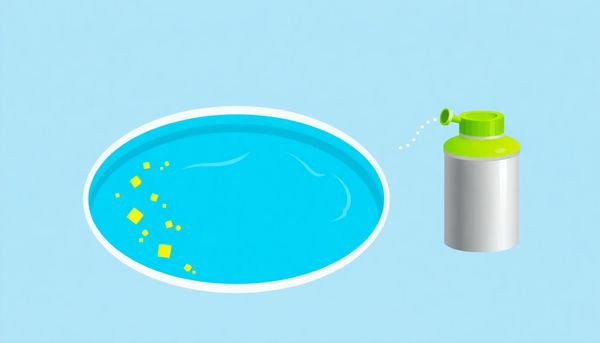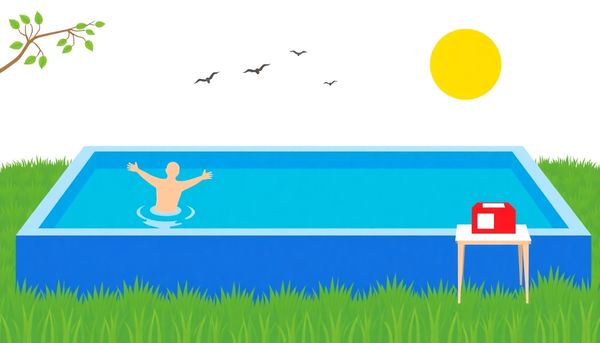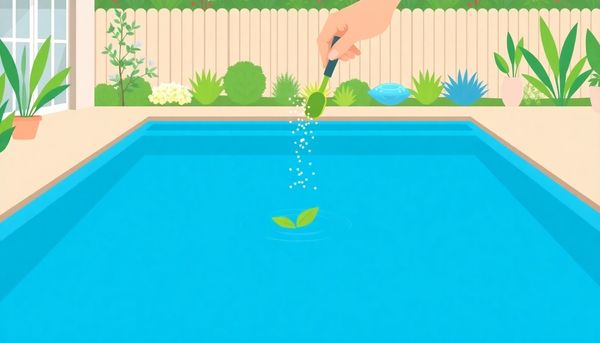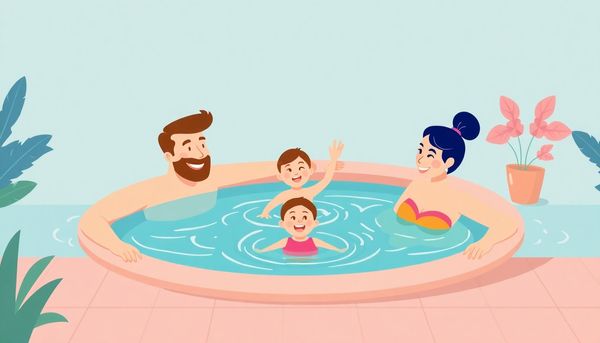Discover the Benefits of Non-Chlorine Pool Shock
July 04th, 2024
July 04th, 2024
On a sweltering summer afternoon, the allure of diving into a crystal-clear pool is irresistible. For many pool owners, maintaining such clarity often brings to mind the familiar scent of chlorine. This chemical standard has been a steadfast ally in keeping pools immaculate and safe from unwanted bacteria and algae. Yet, in recent years, whispers of non-chlorine alternatives have been making waves, causing many to reevaluate their pool maintenance rituals.
About a year ago, my neighbor swapped his pool’s traditional chlorine regimen for non-chlorine shock. At first, I was skeptical, envisioning murky waters and endless maintenance woes. However, his pool remained pristine, free from the pungent smell often associated with chlorine-treated water. This got me thinking: could non-chlorine shock be a superior choice for our beloved backyard oases?
Non-chlorine shock treatments, primarily composed of potassium monopersulfate, offer a different approach to pool care. Instead of sanitizing by directly killing bacteria, they work by oxidizing contaminants, allowing chlorine to focus on sanitization more efficiently. This distinction not only helps maintain water clarity but also reduces the chemical skin irritations that some swimmers experience.
Intrigued by these benefits, more pool owners are exploring non-chlorine options. The question then arises: is this method genuinely better than traditional chlorine, or is it just a fleeting trend? Understanding the nuances between these two treatments can help you make an informed decision, ensuring your summer days remain as refreshing as ever.

Choosing non-chlorine shock for pool maintenance can feel like discovering a hidden gem for many pool owners. Unlike its chlorine counterpart, which tends to be more aggressive, non-chlorine shock offers a gentler yet effective solution for maintaining clear and inviting water. One of its primary advantages is its ability to let you dive back into the pool much sooner—just 15 minutes after treatment. This aspect alone is a game-changer for those spontaneous swim sessions that are often hindered by the long wait times of chlorine shock treatments.
My neighbor once shared how her family switched to non-chlorine shock for their saltwater pool. They found it particularly beneficial as it avoided the pesky calcium buildup that could damage pool equipment. This choice not only preserved the integrity of their pool system but also sidestepped the harsh chemical exposure to swimmers, making pool time more enjoyable and less of a waiting game.
Another noteworthy benefit is its ability to stabilize pool chemistry. While chlorine shocks can cause fluctuations in pH and alkalinity, non-chlorine options maintain balance, allowing you to focus on enjoying your pool rather than constantly adjusting chemical levels. It's perfect for smaller pools and saltwater systems where high chlorine concentrations can be problematic. However, keep in mind that for severe algae problems or deep cleanings, chlorine shock might still be necessary. In essence, non-chlorine shock supports a more harmonious pool environment, keeping your water pristine without disrupting your day.
Understanding the perks of non-chlorine shock can transform pool maintenance into a smoother, more enjoyable task. Unlike traditional chlorine shocks, which demand a lengthy wait before swimming, non-chlorine shock lets you dive in just 15 minutes post-treatment. This quick turnaround is perfect for spontaneous pool days when the water needs a quick refresh but guests are on their way.
Non-chlorine shock operates through oxidation, attacking pesky organic contaminants like oils and sweat, while efficiently breaking down lotions and deodorant. This not only cleanses the water but also revitalizes your existing sanitizer, making chlorine work smarter, not harder. As a result, you’re less likely to face issues with algae or cloudy water, keeping your pool invitingly clear.
For those managing smaller or saltwater pools, the benefits multiply. With no added chlorine, it sidesteps the complications of elevated chlorine levels, which can be particularly tricky in compact pools. Plus, the absence of calcium means avoiding unwanted scale build-up, a common nuisance in saltwater systems.
However, using non-chlorine shock requires a balance. While it maintains stable cyanuric acid levels, overuse can dip your pool’s pH, demanding slight chemical adjustments to bring things back to normal. Following manufacturer guidelines and monitoring pool chemistry helps maintain this balance effectively.
In essence, non-chlorine shock offers a gentle, efficient option for routine maintenance, ideal for those looking to enjoy their pool with fewer interruptions and a more natural approach to water care.
In the intricate dance of pool maintenance, understanding the difference between oxidizing and sanitizing is key. Imagine a bustling kitchen: sanitizing is akin to scrubbing surfaces to kill germs, while oxidizing is like throwing open a window to clear the air. In the realm of pool care, these processes serve equally vital but distinct roles.
Oxidizing, the primary function of non-chlorine shock, is about breaking down organic compounds such as body oils and lotions that sneak into your pool. This process not only refreshes the water by eliminating unwanted pollutants but also rejuvenates the free chlorine available to fight bacteria effectively. Non-chlorine shock, often packaged as potassium monopersulfate, excels here—acting without raising chlorine levels, allowing for safe swimming within mere minutes.
Conversely, sanitizing with chlorine shock is a more aggressive approach, targeting bacteria with the precision of a practiced chef's knife. This method is indispensable when battling stubborn algae blooms or when your pool’s clarity has taken a nosedive. However, it requires patience, as swimming must be postponed until chlorine levels drop to safe margins.
Drawing a line between these two helps in choosing the right tool for the job. For routine maintenance, non-chlorine shock is a gentle yet effective choice, ensuring your pool stays inviting without the harsh side effects of elevated chlorine. Understanding these dynamics not only keeps your pool sparkling but also enhances the overall enjoyment of your aquatic oasis.
Unraveling the secret to a sparkling pool often comes down to understanding the tools at your disposal. Non-chlorine shock treatments have carved out a niche for pool enthusiasts seeking a gentle yet effective maintenance routine. Unlike their chlorine-heavy counterparts, non-chlorine shocks, such as potassium monopersulfate (MPS), tackle contaminants through oxidation. This process not only eliminates organic residue but also enhances the efficiency of the existing chlorine by breaking down chloramines, those pesky compounds responsible for cloudy water and irritation.
In my own backyard oasis, I've discovered that using non-chlorine shock weekly keeps water clarity and comfort levels high. Its appeal lies in its subtlety—after treating the pool, swimming can resume in as little as 15 minutes, a luxury chlorine shocks can't offer. Particularly in saltwater pools or smaller setups, where over-chlorination poses a risk, non-chlorine alternatives strike the perfect balance by maintaining consistent chlorine levels.
Safety, however, remains paramount. Even with gentler chemicals, proper precautions are necessary. I always don gloves and protective eyewear and ensure precise adherence to dosing instructions to prevent any mishaps. Despite its mild nature, overzealous application can lead to imbalanced pH levels, necessitating adjustments with pH increasers. Thus, careful handling ensures a pristine pool environment without sacrificing peace of mind.

In the bustling realm of pool maintenance, safety isn't just about preventing slips and falls—it's about ensuring the water itself is a healthy environment for swimmers. Non-chlorine shock treatments offer an unexpected ally in this pursuit, particularly for those with sensitive skin or respiratory issues. By relying on oxidation rather than harsh chemicals to tackle impurities, these treatments significantly reduce the pungent chloramine odor often associated with traditional shock methods. This makes pool time more pleasant without compromising cleanliness.
Let’s talk practicality. Imagine hosting a poolside gathering, where guests can enjoy a swim without the long wait times necessitated by chlorine shock treatments. With non-chlorine shock, you can add the treatment shortly before your guests arrive, and within minutes, the water is swimmable—fresh, clear, and inviting. This convenience doesn’t come at the cost of effectiveness; non-chlorine shock effectively eliminates organic contaminants, ensuring a safe swimming experience.
Moreover, for those managing saltwater systems, non-chlorine shock plays a pivotal role in maintaining balanced chlorine levels. Saltwater pools naturally generate chlorine, and adding more through traditional shock can lead to over-saturation, affecting both the water quality and your equipment. Switching to non-chlorine alternatives helps preserve the integrity of your pool setup, while still supporting the filtration system and reducing the likelihood of unwanted buildup. In essence, non-chlorine shock provides a blend of safety, comfort, and efficiency, making it an essential tool in the modern pool owner's maintenance kit.
Grabbing a scoop of non-chlorine shock might seem straightforward, but ensuring its safe use requires a little finesse. Let's start with your attire: protective gloves and goggles aren't just for lab technicians—they're essential for anyone handling pool chemicals. These items shield your skin and eyes from potential irritants.
When it comes to applying the shock, consider your delivery method. Many pool owners prefer to broadcast it directly into the water. However, on a breezy day, you might find more of it landing on the deck than in the pool. In that case, pre-mixing is your ally. Simply stir the shock in a five-gallon bucket of water with a wooden spoon and pour the solution evenly around the pool's perimeter.
Don’t forget to consult the manufacturer’s dosing instructions. This isn't the time for guesswork, as too much can affect your pool's pH balance, turning the water into an acidic cocktail that demands further correction.
After administering the shock, patience is key. Set a timer for about 15 minutes before diving in. This brief wait ensures that the shock has done its job, clearing away unwanted contaminants and leaving the water safe for a swim. These small steps can make your pool maintenance both effective and stress-free.
Among the many tools available for pool upkeep, non-chlorine shock stands out for its ability to amplify the performance of your sanitizer. Your pool's sanitizer, typically chlorine, is on constant duty, fighting off bacteria and preventing algae blooms. However, its efficiency can wane over time as chloramines accumulate. Enter non-chlorine shock, an unsung hero in the pool maintenance world. Acting as an oxidizer, it dismantles these pesky chloramines, freeing up your chlorine to do what it does best—sanitize.
Consider this scenario: it’s a warm afternoon and the pool is bustling with swimmers. In the aftermath, there’s a cocktail of sweat, oils, and lotions mingling with the water. Instead of waiting for chlorine to wrestle with these invaders alone, a dose of non-chlorine shock can kickstart a rapid cleanup. Within 20 minutes, the water is clear and inviting again, ready for the next round of fun.
The advantages of non-chlorine shock extend beyond just maintaining balance. By reducing foaming and easing the load on your filters, it also trims down the need for additional chemicals. It’s an efficient partner in keeping your pool pristine without the downtime associated with chlorine shock, giving you more time to enjoy those sunlit swims.
Guarding against the invasion of algae in your pool is akin to fending off an unwelcome guest at a summer barbecue. Regular treatment with non-chlorine shock can be your secret weapon in this battle. Unlike chlorine, which can be harsh and require hours of waiting before diving back into the water, non-chlorine shock acts swiftly, allowing you to resume swimming typically within 15 minutes. This makes it especially convenient for those spontaneous swim sessions.
The magic behind non-chlorine shock lies in its ability to boost the effectiveness of existing sanitizers. When non-chlorine shock is applied consistently, it helps maintain a balance in the pool’s ecosystem by oxidizing organic materials and reducing contaminants. This not only keeps your water pristine but also minimizes the workload on your pool’s filtration system, effectively extending its lifespan.
Once, during a particularly warm summer, my backyard pool seemed to be growing its own forest of algae. Switching to a routine of weekly non-chlorine shock treatments transformed the water from murky to crystal clear in a matter of days. This approach not only tackled the immediate problem but also established a protective barrier against future algae growth.
For pool owners, especially those with saltwater systems, integrating non-chlorine shock into their maintenance routine is a proactive step toward effortless and effective pool care. Embracing this method ensures a serene swimming experience without the harsh consequences of traditional chlorination.

Revamping your pool-cleaning routine can transform how you enjoy and maintain your watery oasis. Many pool owners have discovered that integrating non-chlorine shock into their regimen offers cleaner, clearer water with fewer side effects. By understanding the subtleties of your pool's needs, you can maximize the benefits of non-chlorine shock treatments and keep the pool pristine with minimal effort.
Kick off your maintenance by assessing your pool's weekly requirements. For smaller or saltwater pools, where chlorine levels can quickly spike, non-chlorine shock proves to be an ideal choice. It maintains water clarity without the harshness of traditional chlorine shocks, allowing for a swim-ready pool in a mere 15 to 20 minutes. This quick turnaround means more time in the water and less time waiting on chemical adjustments.
Keep an eye on your pool’s pH and alkalinity levels, as non-chlorine shock can affect them. If your pool's pH dips, a simple addition of soda ash or baking soda can restore balance. Regularly testing water chemistry not only prevents unwanted surprises but also ensures that your non-chlorine shock works efficiently.
By pairing non-chlorine shock with a regular sanitizer like chlorine, you'll boost the sanitizer’s effectiveness, reducing the likelihood of algae blooms and bacterial contamination. This dynamic duo will keep your water inviting and fresh, making pool maintenance less of a chore and more of an art.
Choosing the right type of shock for your pool is like picking the perfect tool for a specific task. Each type of shock serves a unique purpose, and understanding these differences ensures your pool remains a sparkling oasis without unnecessary downtime. Non-chlorine shock, particularly potassium monopersulfate (MPS), excels as a routine solution. It’s perfect for regular maintenance, keeping water clear and free from organic contaminants like sweat and oils, while allowing you to swim shortly after treatment.
For everyday upkeep, especially in saltwater or smaller pools, non-chlorine shock is your ally. It supports your existing sanitizer by oxidizing waste, thus enhancing your pool’s cleanliness and clarity without the harshness of elevated chlorine levels. This is crucial in saltwater setups, where maintaining stable chlorine levels is challenging. A non-chlorine shock fits seamlessly into this environment, avoiding excessive chlorine buildup that could lead to irritation or damage to pool equipment.
However, when facing stubborn algae or severe contamination, the more potent chlorine shock steps up. Its powerful sanitizing ability tackles persistent problems, albeit at the cost of a temporary spike in chlorine levels, necessitating a wait before swimming. Thus, while non-chlorine shock is a versatile, gentle option for regular use, chlorine shock is indispensable for tackling more severe challenges. Knowing when to use each type ensures your pool remains a safe, inviting retreat.
When pondering pool upkeep, enhancing sanitization efficiency is a game-changer. Rather than relying solely on traditional chlorine methods, the non-chlorine shock offers a modern twist on maintaining a pristine swimming environment. This approach is especially beneficial for those keen on swimming without delay, as it allows for a quick return to the water after treatment.
Consider the oxidation prowess of non-chlorine shock. Unlike its chlorine counterpart, which sanitizes by killing bacteria, non-chlorine shock functions as an oxidizer. It breaks down organic matter such as sweat and oils, improving the overall effectiveness of your existing sanitizer. As a result, it reduces the accumulation of chloramines, those pesky compounds responsible for unpleasant odors and eye irritation. The pool not only looks cleaner but feels more inviting.
Moreover, the application of non-chlorine shock brings about a harmonious balance in water chemistry. It prevents the fluctuations in calcium hardness levels, thereby safeguarding your pool's infrastructure from troublesome scale buildup. This is particularly advantageous for those managing saltwater pools, where calcium deposits can wreak havoc on equipment.
Ultimately, incorporating non-chlorine shock into your pool routine enables the sanitizer to operate at peak performance without increasing chlorine levels unnecessarily. This method supports a consistent and safe swimming experience, ensuring clarity without compromising on comfort or safety. Balancing efficiency with tranquility, non-chlorine shock might just be the unsung hero of your pool maintenance routine.
Tackling algae growth in your pool can sometimes feel like an uphill battle. However, with a consistent maintenance routine, you can keep this unwelcome guest at bay. Regular upkeep, including the use of non-chlorine shock, plays a crucial role in preventing algae from taking hold. Non-chlorine shock serves as an effective oxidizer, eliminating organic debris and preventing the formation of chloramines, which can cloud your water and irritate skin and eyes.
Consider the non-chlorine shock as your pool's secret weapon. By using it weekly, you're not only enhancing your sanitizer's efficiency but also maintaining a balance that discourages algae growth. This method is particularly beneficial for saltwater pools, where high chlorine levels can disrupt the ecosystem. Regular shock treatments ensure that your pool water remains clear, clean, and inviting.
On a personal note, I once managed a friend's pool that was notorious for algae blooms. Incorporating a routine of non-chlorine shock transformed that troublesome water into a sparkling oasis. The secret was consistency. By committing to regular treatment, we managed to maintain a healthy pool environment without the harsh side effects of excessive chlorine use.
Remember, proactive maintenance is key. Keep up with your routine, monitor your water chemistry, and let non-chlorine shock do its magic. Your pool will thank you with crystal-clear waters and fewer unwanted green visitors.

When it comes to achieving crystal-clear pool water, non-chlorine shock treatments offer a gentle yet effective alternative to their chlorine counterparts. Unlike traditional methods that rely on high chlorine levels, non-chlorine shock works by oxidizing impurities, thus enhancing the efficacy of the existing sanitizers without the harsh side effects. This approach not only maintains clarity but also ensures a more enjoyable swimming experience without the long wait times for chlorine levels to drop.
Non-chlorine shock, particularly potassium monopersulfate (MPS), excels at eliminating organic contaminants like body oils and sweat, along with inorganic substances such as lotions. These impurities, if left unchecked, can cloud the water and overburden the filtration system. Regular use of non-chlorine shock helps keep these contaminants at bay, reducing the need for additional chemicals and easing the strain on filters. It's a remarkable balance of maintaining clarity while respecting the water chemistry.
In my own small backyard pool, switching to a non-chlorine shock regimen transformed the way we enjoyed our swims. The water felt fresher and the constant battle against cloudy water became a thing of the past. Plus, with no lingering chemical smell, my family could jump in almost immediately after treatment. Adopting this approach not only improved water clarity but also ensured that our pool remained a safe, inviting oasis throughout the summer months.
Choosing the right shock for your pool involves more than simply grabbing the nearest product off the shelf. Each type of shock serves a unique purpose, and understanding when and why to use them can make a significant difference in maintaining your pool’s pristine condition. Non-chlorine shock, like potassium monopersulfate (MPS), is often the hero for regular maintenance, particularly in smaller or saltwater pools. This option shines when quick-swimming access is needed, as it allows for a dip just 15 minutes post-application, unlike chlorine shock, which requires waiting hours for safe chlorine levels to return.
Non-chlorine shock excels in maintaining clarity and balance by oxidizing organic substances—think sweat and sunscreen—that often cloud water. It's a gentle nudge for your chlorine sanitizer, helping it work more effectively without the harshness and side effects associated with chlorine spikes. This makes it a superb choice for routine use, preventing issues like algae growth while keeping pH levels stable.
However, for those pesky, stubborn algae blooms, chlorine-based shocks remain unmatched in potency. They act like a detox for your pool, resetting everything when regular maintenance isn’t enough. Knowing when to switch between these options can save time and effort, keeping your pool crystal clear and inviting all season long.
Mastering the art of using non-chlorine shock can elevate your pool maintenance routine. Think of it as giving your pool a quick, revitalizing boost without the harshness of traditional chlorine shock. It's the subtle difference between a strong espresso shot and a gentle cold brew. Both wake you up, but one does it with less intensity.
Timing is everything. For those with smaller or saltwater pools, integrating non-chlorine shock on a weekly basis can be your secret weapon against the accumulation of pesky organic contaminants. Consistency helps prevent potential problems like cloudy water or an unwelcome algae bloom. However, if you find yourself facing stubborn algae, be prepared to switch gears to a chlorine shock for a more aggressive approach.
Pay attention to your pool's chemistry. While non-chlorine shock doesn’t affect chlorine levels directly, it might alter your pH balance. An unexpected drop might demand a little TLC with a pH increaser to keep everything in check. My friend once overdosed her pool with non-chlorine shock and found herself scrambling to fix the pH imbalance just before a big weekend gathering. A lesson learned.
Embrace the ease of preparation. If you're wary of windy days whisking your treatment away, consider pre-mixing the shock in a bucket and pouring it carefully around the pool’s edge. This simple step ensures even distribution and keeps your efforts from blowing away.
When handling non-chlorine shock, safety should be your first priority. Ensuring proper application not only protects you but also maintains the balance of your pool's ecosystem. Start by donning gloves and protective eyewear before you even open the container. These precautions may seem excessive for a chemical that seems less harsh than its chlorine counterpart, but they’re essential to prevent skin irritation and accidental splashes to the eyes.
Next, consider the weather conditions. A windy day can turn a simple task into a messy ordeal if powder drifts onto nearby plants or surfaces. Opt for calm days to avoid scattering granules or consider pre-mixing the shock in a five-gallon bucket of water. Whisk it with a wooden spoon until dissolved, and evenly distribute the solution around the pool’s perimeter. This method also ensures even distribution and less waste.
Adhering to the manufacturer's dosing instructions is crucial. Overdosing can lower your pool's pH, leading to water imbalance that requires additional chemicals to correct. After application, a 15-minute wait is usually sufficient before taking a dip, but always double-check your pool's pH levels afterward. Testing kits or strips can confirm that everything’s in balance.
Through mindful application, you’ll keep your pool safe and inviting while enjoying the benefits of non-chlorine shock.

Algae may be the uninvited guest that every pool owner dreads, but with the right strategy, it can be kept at bay effectively. Enter the hero: non-chlorine shock with its powerful oxidizing capabilities. This treatment doesn't just sit on the surface; it gets to work by attacking the organic contaminants that algae thrive on. By breaking down these pollutants, non-chlorine shock indirectly starves algae of its nutrients, making your pool less hospitable to these pesky invaders.
Several summers ago, a friend of mine was battling a persistent algae problem in her saltwater pool. Despite her best efforts with chlorine-based products, the green menace kept returning. Switching to a non-chlorine shock routine turned out to be a game-changer. By maintaining a consistent schedule of weekly treatments, not only did the algae retreat, but the water also remained clear enough to reflect the sun like a mirror.
The secret lies in the oxidization process. Non-chlorine shock removes the by-products that can render your regular chlorine sanitizer less effective. So, when your sanitizer is functioning at its optimum level, it becomes a double-edged sword against algae and cloudy water. Plus, since it's gentler on the skin and eyes, you can dive back in soon after, making pool maintenance feel less like a chore and more like a part of enjoying your pool.
Selecting the perfect shock treatment for your pool can feel like navigating a chemistry experiment. Whether you're dealing with a backyard oasis or a saltwater haven, understanding when to employ non-chlorine shock is key. Unlike chlorine shock, non-chlorine shock, typically composed of potassium monopersulfate (MPS), focuses on oxidizing contaminants rather than sanitizing them. This means it's gentler on the pool’s ecosystem and allows for almost immediate swimming—ideal for spontaneous poolside parties or quick dips.
Consider your pool's personality. Saltwater pools, with their built-in chlorination systems, benefit greatly from non-chlorine shock as it avoids adding unnecessary chlorine, which can lead to calcium buildup. Smaller pools, too, benefit from this milder option, given their propensity for rapid chemical fluctuations. If you prefer keeping your swim time flexible without waiting hours for safe chlorine levels, non-chlorine shock is your go-to choice.
However, it’s crucial to recognize its limitations. For stubborn algae invasions or murky waters, a more powerful chlorine-based shock might be necessary to reset your pool's clarity and safety. Balancing regular maintenance with occasional heavy-duty cleaning ensures a pristine swimming environment. Remember, while non-chlorine shock is forgiving in its application, overuse can tip your pool's pH balance, so always measure carefully and follow manufacturer's guidelines for optimal water harmony.
Applying non-chlorine shock effectively requires some finesse, akin to perfecting a recipe where each ingredient plays a pivotal role. Begin by ensuring your pool's circulation system is running; this helps distribute the shock evenly throughout the water. Typically, non-chlorine shock comes in granular form, so accuracy with your measurements is crucial. A general rule of thumb is to use one pound of shock per 10,000 gallons of water, but always follow the manufacturer's instructions for best results.
Now, there's a little trick some pool enthusiasts swear by—pre-dissolve the shock in a bucket of water before adding it to your pool. This minimizes the risk of granules settling on the pool floor, which could potentially cause staining. Be sure to stir the mixture until fully dissolved, and then slowly pour it around the pool's perimeter. This method is particularly useful on windy days when granules might otherwise blow away.
After adding the shock, patience is your ally. Although non-chlorine shock allows for a quick return to swimming, give it at least 15 minutes to work its magic. During this time, you might want to double-check your pool's pH levels. Non-chlorine shock can sometimes lower the pH, so be prepared to adjust if necessary. By following these steps, you ensure your pool remains a crystal-clear oasis, ready for that refreshing dive at a moment’s notice.
Balancing water chemistry is akin to orchestrating a symphony where every element must hit the right note. Unlike chlorine shock, which can sometimes throw off this balance, non-chlorine shock offers a gentler touch. It’s a bit like having a friend who tidies up without rearranging your entire living room. Yet, there's a catch: non-chlorine shock can nudge the pH and alkalinity levels downward. A gentle nudge, yes, but one that might require a little attention afterward.
Let's consider pH, the maestro of your pool's environment. Non-chlorine shock's acidity could lower pH below the sweet spot of 7.4 to 7.6, akin to a slightly off-pitch note in an otherwise perfect melody. To counteract this, tools like pH increasers become your best allies, restoring harmony without much fuss. Similarly, maintaining alkalinity ensures that pH levels don’t swing wildly, preserving a stable aquatic environment.
Using non-chlorine shock regularly can also prevent calcium buildup, a notorious villain in pool maintenance. Calcium scaling is less likely to occur, which keeps your pool surfaces and equipment free from stubborn deposits. This aspect particularly benefits saltwater pools, where calcium management is crucial.
In essence, while non-chlorine shock helps maintain cleaner water, keeping an eye on pH and alkalinity ensures your pool remains in perfect balance, allowing for a safe and enjoyable swim.

This article provided insights into maintaining your pool. Start your pool care journey today!
Want to become a pool maintenance expert? Our free Pool School course covers everything you need to know about pool care. From basic maintenance to advanced troubleshooting, you'll learn how to:
Join over 10,000 pool owners who have already transformed their pool care routine. Get started with our free Pool School course today!